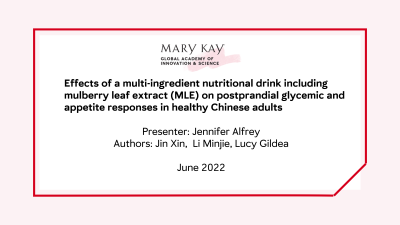Back

Objectives: Our study aimed to evaluate the impact of adding MLE to a nutritional drink containing protein, fat, carbohydrate (maltodextrin) on maltodextrin digestion in-vitro and postprandial glucose and appetite responses in healthy Chinese adults.
Methods: Two randomized cross-over trials were conducted in healthy Chinese adults (20-40 y; 19-24 kg/m2) measuring glucose, hunger and satiety responses. Visual Analog Scale (VAS) was used to evaluate hunger and satiety. In trial 1, participants (n=12) received either 25g anhydrous glucose powder mixed in water or the tested nutritional drink (25g carbohydrate and MLE). Blood glucose was tested 5 min before and at 0, 15, 30, 45, 60 ,90, and 120 min after sample intake. In trial 2, participants (n=10) received either the MLE nutritional drink (~200kcal) or a reference food with similar energy and macronutrient composition but no MLE. VAS results were collected at 0, 30, 60, 90 and 120 min after sample intake. An in-vitro digestion study was conducted using 3 different ratios of MLE and maltodextrin to explore the effects of MLE on maltodextrin digestion.
Results: Baseline glucose levels were similar between the two groups. Postprandial glucose was significantly lower in the test group at 15 min (5.9 ± 0.3mmol/L vs 7.4 ± 0.4mmol/L), 30 min (5.9 ± 0.7mmol/L vs 8.3 ± 0.7mmol/L) and 45 min (5.7 ± 0.6mmol/L vs 7.0 ± 0.9mmol/L) compared to reference group. Glucose iAUC0-120 min was also significantly lower (64.6 ± 11.1mmol/L x min vs 135.0 ± 14.5mmol/L x min) in the test group. In trial 2, VAS desire to eat iAUC0-120 min, was significantly lower (-494.9 ± 80.97cm x min vs -307.4 ± 52.05cm x min) in MLE test group, but other satiety parameters were similar between the two groups. Maltodextrin hydrolysis rate (in-vitro digestion study) iAUC0-180 min was significantly inhibited by MLE (P < 0.05) at ratio of 20:1 and 10:1 (Maltodextrin:MLE).
Conclusions: Consumption of tested nutritional drink with optimized MLE dose produced a significant lower postprandial glucose response and meets the ISO requirements to be claimed low GI. Moreover, the satiety (as measured by desire to eat using VAS) is higher than the reference food with similar energy and macronutrient composition without MLE. Therefore, adding MLE into nutritional drink lowers GI, reduces postprandial glucose response and may promote satiety.
Funding Sources: Mary Kay, Inc.
Dietary Bioactive Components
(PO07-05-22) Effects of Multi-Ingredient Nutritional Drink Including Mulberry Leaf Extract (MLE) on Postprandial Glycemic and Appetite Responses in Healthy Chinese Adults


Jennifer Alfrey, M.S., CCN
– Sr. Director Global Nutrition, Mary Kay Inc., Lewisville, Texas, United States- XJ
Xin Jin, PhD
– Mary Kay Inc. - ML
Minjie Li, PhD
– Mary Kay Inc. - LG
Lucy Gildea, PhD
– Mary Kay Inc.
Presenting Author(s)
Co-Author(s)
Disclosure(s):
Jennifer Alfrey, M.S., CCN: No relevant financial relationship(s) with ineligible companies to disclose.
Objectives: Our study aimed to evaluate the impact of adding MLE to a nutritional drink containing protein, fat, carbohydrate (maltodextrin) on maltodextrin digestion in-vitro and postprandial glucose and appetite responses in healthy Chinese adults.
Methods: Two randomized cross-over trials were conducted in healthy Chinese adults (20-40 y; 19-24 kg/m2) measuring glucose, hunger and satiety responses. Visual Analog Scale (VAS) was used to evaluate hunger and satiety. In trial 1, participants (n=12) received either 25g anhydrous glucose powder mixed in water or the tested nutritional drink (25g carbohydrate and MLE). Blood glucose was tested 5 min before and at 0, 15, 30, 45, 60 ,90, and 120 min after sample intake. In trial 2, participants (n=10) received either the MLE nutritional drink (~200kcal) or a reference food with similar energy and macronutrient composition but no MLE. VAS results were collected at 0, 30, 60, 90 and 120 min after sample intake. An in-vitro digestion study was conducted using 3 different ratios of MLE and maltodextrin to explore the effects of MLE on maltodextrin digestion.
Results: Baseline glucose levels were similar between the two groups. Postprandial glucose was significantly lower in the test group at 15 min (5.9 ± 0.3mmol/L vs 7.4 ± 0.4mmol/L), 30 min (5.9 ± 0.7mmol/L vs 8.3 ± 0.7mmol/L) and 45 min (5.7 ± 0.6mmol/L vs 7.0 ± 0.9mmol/L) compared to reference group. Glucose iAUC0-120 min was also significantly lower (64.6 ± 11.1mmol/L x min vs 135.0 ± 14.5mmol/L x min) in the test group. In trial 2, VAS desire to eat iAUC0-120 min, was significantly lower (-494.9 ± 80.97cm x min vs -307.4 ± 52.05cm x min) in MLE test group, but other satiety parameters were similar between the two groups. Maltodextrin hydrolysis rate (in-vitro digestion study) iAUC0-180 min was significantly inhibited by MLE (P < 0.05) at ratio of 20:1 and 10:1 (Maltodextrin:MLE).
Conclusions: Consumption of tested nutritional drink with optimized MLE dose produced a significant lower postprandial glucose response and meets the ISO requirements to be claimed low GI. Moreover, the satiety (as measured by desire to eat using VAS) is higher than the reference food with similar energy and macronutrient composition without MLE. Therefore, adding MLE into nutritional drink lowers GI, reduces postprandial glucose response and may promote satiety.
Funding Sources: Mary Kay, Inc.

.png)
